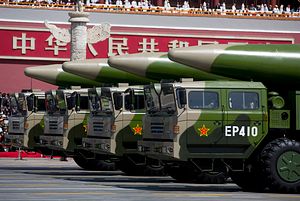Last week, I commented briefly on the pre-launch ambiguity issues associated with the People’s Liberation Army Rocket Force’s (PLARF) dual-capable DF-26. This intermediate-range ballistic missile appears to have been built from the ground-up with conventional and nuclear strike options in mind, introducing dangerous ambiguities that might make inadvertent escalation in a crisis more likely.
This same danger, however, may be part of what grants Chinese leaders the confidence that the system is a good idea in the first place. There’s some evidence American policymakers have started considering what the DF-26’s co-mingled nuclear-conventional units might mean for escalation — at least if a recent Department of Defense report on Chinese military power is a reliable indicator.
Shortly after my commentary, Joshua Pollack and Scott LaFoy, both first-rate analysts, penned a deep empirical dive at Arms Control Wonk into how the DF-26’s physical feature set distinguishes it from the rest of the PLARF’s inventory. The full analysis is worth a read for anyone with even a passing interest in the PLARF’s strategic systems, but what’s particularly interesting is how the DF-26’s launcher configuration appears to have been designed to physically enable it to be “hot-swappable” between conventional and nuclear payloads.
Pollack and LaFoy draw attention to an interesting nugget: the DF-26 was first seen at a military parade in 2015 and, while those images remain widely used in news coverage of the system, the launcher configuration underwent an important change thereafter and was never again seen publicly in precisely the same configuration that was seen at the parade. The authors note that we don’t know why exactly the parade configuration varied, but one explanation they offer was that the missile’s explicitly dual-capable nature — and more specifically, its “hot-swappable” nature — was not “cleared for public release.”
I won’t re-describe the physical changes observed between the parade units and the post-parade units, but, in short, the post-parade units appear to have a hinged, recessed horizontal cover for the missile’s warhead section built into the transporter-erector-launcher’s cab. This implies that the canisterized booster for the DF-26 can be inserted into the TEL and, depending on precise operational scenarios, either a conventional or a nuclear payload can be added. (If this sounds even slightly interesting, you should read the full analysis by Pollack and LaFoy, which includes several good images pointing out the changes.)
So far, it looks as if the DF-26 is unique among the PLARF’s inventory to have this feature.

































